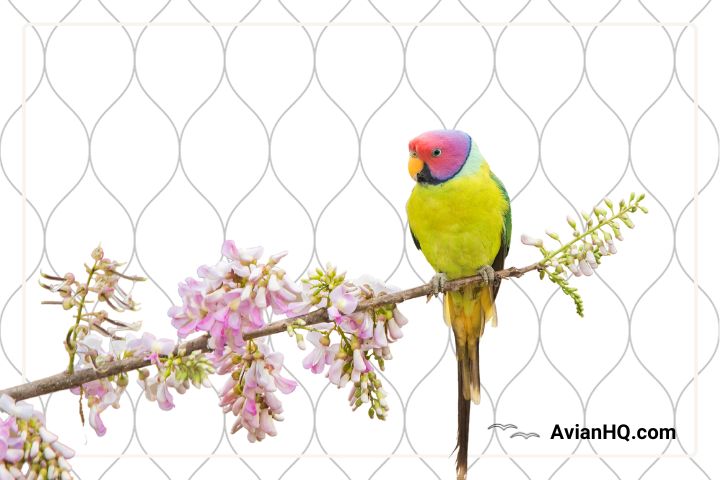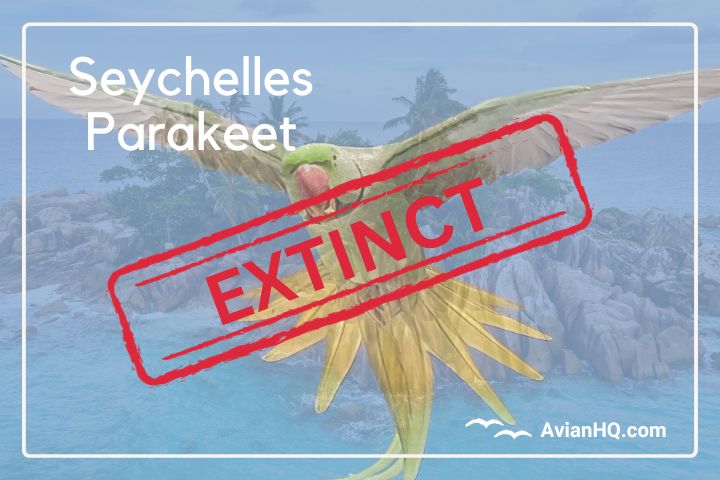What Size Cage Does A Plum Headed Parakeet Need?
The minimum dimensions for a plum-headed parakeet’s cage are 36 inches in length, 24 inches in depth, and 36 inches in height. However, the focus should be on providing an appropriate living environment for your plum-headed parakeet in order to be healthy and content.
These medium-sized parrots with long, tapering tails need more space than their small stature suggests. In the wild, plum headed parakeets are highly social and fly between trees while foraging over a large territory. Captivity in too cramped of quarters can cause stress, feather plucking, and other problems.
So if you’re considering adding one of these beautiful parrots to your family, it’s important to understand their physical traits and minimum cage requirements. This ensures you can provide an enclosure with sufficient room to move and play. Read on to learn more about what size cage your plum headed parakeet needs to thrive.
Read Next: Can Plum Headed Parakeets Talk?
Plum Headed Parakeet Size and Dimensions
Though small by parrot standards, plum headed parakeets are larger than many other popular pet bird species. On average, they reach a total length of 12 to 14 inches when full grown. This includes their long, graduated tail which can extend up to 9 inches or more beyond the body.
Overall, these slender birds tend to weigh around 2.3 to 2.8 ounces. Their wingspan stretches approximately 14 inches tip to tip. While their bodies are compact at just a few inches long, the plum headed parakeet’s extraordinary tail accounts for over half their total size.
Exact Measurements
To be more precise, the average measurements of an adult plum headed parakeet are:
- Total length: approx 32 cm or 12.5 inches
- Tail length: about 20 cm or 8 inches
- Wingspan: approx 38 cm or 15 inches
- Weight: around 49 g or 1.7 ounces
So while their body proportions are similar to other parakeets, the plum headed’s giant graduated tail sets them apart. This long plume must be accommodated when considering cage size and setup. Keep reading to learn their minimum requirements.
Minimum Cage Size Requirements
Due to their large tail and active nature, plum headed parakeets require a relatively sizeable cage compared to other petite bird species. At an absolute minimum, the enclosure should measure:
- 36 inches long
- 24 inches deep
- 36 inches high
This provides the basic elongated footprint and vertical space these parrots need for their long tail and ability to fly short distances.
The bar spacing between wires should not exceed 1/2 inch. Any wider risks the bird squeezing through and escaping or getting stuck.
When sitting, your plum headed parakeet should not be able to touch the sides of the cage. Some room to flap their wings is ideal. The cage must not cramp their movement or appear constricting.
This 24x36x36 inch cage is a bare minimum size. Larger is encouraged if possible. Adding play gyms and perches helps create a more enriching environment as well.
Cage Setup Recommendations
Simply meeting the minimum dimensions is not enough. The proper setup and accessories are key to keeping your plum headed parakeet engaged and comfortable. Here are some tips:
- Include multiple perches of varying widths and textures. Natural tree branches offer nice variety.
- Provide a separate play gym inside the cage outfitted with fun toys, bells, mirrors, and shreddable materials.
- Supply an additional play gym outside the cage for supervised exercise periods.
- Add an assortment of chew toys to satisfy their instinct to gnaw and prevent boredom.
- Allow enough room for short flights from perch to perch or across the cage.
- Position cages out of drafts and direct sunlight.
- Ensure ample room to flap wings without obstruction.
- Use horizontal cages to accommodate their tendency to hop rather than climb.
With size and layout optimized for their needs, your plum headed parakeet will stay active and engaged in their home.
Cage Alternatives and Additions
While a 36″ l x 24″ w x 36″ h cage meets the minimum size needed, you have some additional options to provide an even better habitat.
For a pair of plum headed parakeets, consider housing them in a spacious aviary enclosure. This allows ample room to fly and socialize.
One advantage of the plum headed parakeet is they can peacefully co-exist with other non-competitive bird species in an aviary or flight cage. Finches make good cohabitants as they don’t compete for food or perches.
Even with a properly sized cage, it’s essential to let your parakeet out for supervised play and exercise daily. A bird-safe open room or screen porch offers lots of fun exploration space when you’re able to monitor them.
You can also supplement their main cage with a larger secondary cage used just for playing, socializing, and flying. This provides additional enrichment and activity.
By maximizing both their living and play spaces, your plum headed parakeets will have an enriching world to call home.
Ensuring Your Parakeet’s Health and Happiness
Beyond cage size, there are other vital factors that contribute to your plum headed parakeet’s wellbeing. Here are some tips:
- Feed a balanced diet of pellets, fresh fruits and veggies. Their favorites include apples, oranges, kiwi, beans, carrots.
- Provide fresh, clean drinking water daily and replace as needed. Use bowls designed to prevent splashing.
- Schedule annual checkups with an avian vet to identify any health issues early.
- Supply an assortment of puzzle toys, ladders, mirrors and shredders to prevent boredom.
- Spend time interacting, training, and bonding with your parakeet each day.
- Watch for signs of stress like plucking feathers, screaming, or aggression.
- Ensure they get 10-12 hours of sleep in a quiet, comfortable area.
- Trim overgrown beaks and nails if needed to keep them manicured.
- Look for indications of illness like puffed feathers, wheezing, runny nose.
With the proper environment, socialization, diet and care, your plum headed parakeet will have an enriched life and strong bond with you.
Read Next: Where Do Plum Head Parrots Come From?
Conclusion
For their health and happiness, plum headed parakeets require cages that are relatively spacious compared to similarly sized birds. This accommodates their long graduated tails and active dispositions.
At minimum, aim for a cage around 36 inches long, 24 inches wide, and 36 inches tall. Bar spacing should not exceed 1/2 inch. Include varied perches, toys, and play gyms suited to their chewing, hopping, and climbing behaviors.
Supplement the main cage with ample out-of-cage play time in a secure area. An aviary or large secondary cage provides even more opportunity for exercise and enrichment. Remember to also feed a balanced diet, socialize frequently, and watch for signs of illness or stress.
With the proper cage size and enriching accessories, your plum headed parakeet will have a comfortable home. Paying attention to their specialized spatial and social needs will help ensure a long and healthy life. If considering one of these stunning parrots, be sure you can provide the larger cage they require to spread their long tail feathers and fly freely.








Keep functioning ,remarkable job!